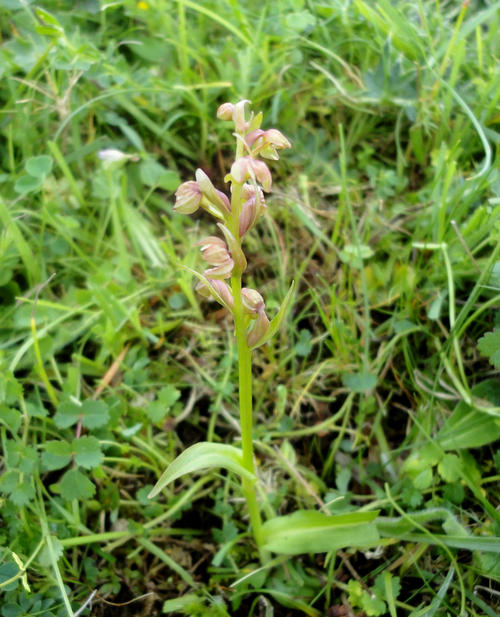The Rediscovery of Frog Orchid (Coeloglossum viride (L.) Hartm.) in Worcestershire.
Roger Maskew
In early July this year while botanising on short, limestone grassland on the slopes of Broadway Park I came across seven scattered plants of Frog Orchid. This is one of the most important finds of recent years and is the first record of the species in the county for thirty-two years. Other orchid species present in the area were Early-purple Orchid Orchis mascula, Common Twayblade Neottia ovata, Common Spotted-orchid Dactylorhiza fuchsii, Bee Orchid Ophrys apifera and Pyramidal Orchid Anacamptis pyramidalis; other notable associates included Clustered Bellflower Campanula glomerata) Kidney Vetch Anthyllis vulneraria and Downy Oat-grass Avenula pubescens.
In southern Britain Frog Orchid is now mainly found from Sussex west to Wiltshire . However, apart from in the Peak District, it is a scarce plant in the Midlands. The most common habitat is well-drained calcareous grassland where it is usually seen as a small, greenish inconspicuous plant less than 15cm in height. It is therefore easily overlooked, although it can occur abundantly; for example I once found it difficult to avoid trampling numerous plants on the limestone at Durness NW Sutherland. On the other hand I have also found plants at least 25cm tall on wet rocky ledges at 900 metres on Ben More Assynt, Sutherland.
In Worcestershire, as elsewhere in much of England, Frog Orchid was also formerly frequent in unimproved pastures, but this habitat is now rare. It was first recorded in the county by Nash (1781) as abundant in meadows and pastures around Great Comberton and Pershore and the earliest specimen I have found was collected by William Mathews from Abberley in 1845. Lees (1867), in the first Flora for the county, lists it for odd sites in all four of his botanical districts and by the end of the 19th Century it had been found in at least twenty-five widely scattered sites with clusters of records from the Malvern and Wyre Forest districts. At the start of the 20th Century Amphlett & Rea (1909) stated “Downs, pastures, heaths. Local” and although there are few records from the 20th Century during the first two decades it was still to be found at Eastham in the Teme Valley and there are specimens in the herbarium of the Worcester Museum which were collected by Richard Towndrow from Little Malvern and Malvern Wells in 1910; it appears to have been last recorded in this district from West Malvern by Christine Dony in 1949. Humphreys (1917) mentions Woodgate near Bromsgrove and also that it was ”sparingly distributed” on the southern slopes of the Lickeys. Certainly during the first half of the 20th Century it was probably still more common and widespread than records suggest. Since then odd plants have been seen from time to time on the embankments of the earthworks at the summit of Bredon Hill. It was spotted here during a field meeting of the Worcestershire Naturalists’ in 1938 and again in 1979 and 1980. I have searched the exact spot several times in recent years without success. In 2002 I also unsuccessfully searched Eades Meadow with orchid expert Richard Bateman.
Suitable habitat still exists in the county and any damp unimproved grassland is worth searching, particularly those on base-rich soils, I have always thought the northern slopes of Bredon Hill look a good bet. Populations can fluctuate enormously from one year to the next, so any potential site is always worth visiting more than once.
References:
Amphlett, J. & Rea, C. 1909.The Botany of Worcestershire. Cornish Bros. Birmingham.
Humphreys, J. 1917. A Survey of the Flora of East Worcestershire. Proceedings of the Birmingham Natural History and Philosophical Society, Vol. XIV, pt. 2, pp. 61-86.
Lees, E. 1867. The Botany of Worcestershire. Worcestershire Naturalists Club. Worcester.
Nash, T.R. 1781. A catalogue of some rare plants. Collections for the History of Worcestershire. Vol. 1, pp. lxxxix-xc. John Nichols. London.
Images
1. Frog Orchid Coeloglossum viride . Roger Maskew
